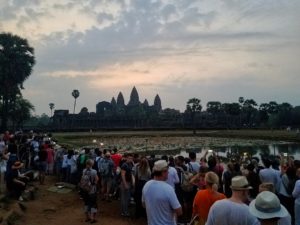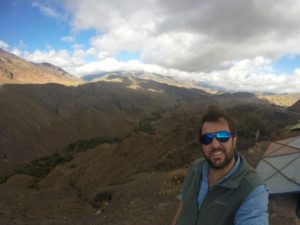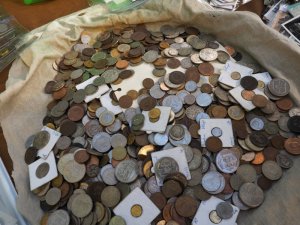Pizza in the Columbia River Gorge is a fun, unique Pacific Northwest dining experience. The Gorge is primarily known for its remarkable landscapes and as a haven for outdoors fun. Aside from hiking, mountain biking, fishing and the like, the Gorge has a limited amount of notoriety regarding food. – [UPDATED 5/2023]

Food-related notoriety in the Gorge largely concerns grapes and fungus. The area is popular with mushroom-lovers for foraging and is also home to dozens of wineries. The unique climate, ideal for viticulture and a utopia for mycophiles, occurs where the soggy Pacific Northwest climate clashes with the dry, inland continental climate at the Cascade Mountains.
For those who aren’t enthralled by geography, it means this: the Columbia River Gorge has a very unique climate; stuff grows here.
What does agriculture and geography have to do with pizza? Absolutely everything!

Pizza in the Columbia River Gorge is a direct reflection of the surrounding environment. Ingredients are largely locally-sourced, and menus are a reflection of local gardens and farms.
Oregon and Washington lack a discernible, distinct cuisine, and this is evident in the Gorge as much or more than anywhere else. Pizza is different. Best of all – let’s be clear, most importantly of all – the pizza is good. As we also show in our Portland Pizza Guide, this area of the country has good pie despite the ongoing culinary identity crisis.
Menus tend to vary seasonally (depending on what’s available) but always include traditional pizzas. Even the classic pies employ local or regional ingredients.
Wild mushrooms are a common, popular staple. If there are greens on the pie, you can bet they are in-season, fresh and local. Pears, cherries, plums – yes, it’s okay, fruit can go on pizza – that’s local, too. When the season arrives, the heirloom tomatoes provide a taste of local that is unmatched and unforgettable.
A “Next Day” rating, from 1 to 5 (bad to good), is also given to each pizza, along with comments on whether the pizza is best reheated in the oven, microwave or eaten cold.
At the end of the list is a brief mention of my favorite neighborhood slice shops.
More travel info for what to do, where to eat and more in the Columbia River Gorge is coming soon!
**The Hangry Backpacker is not an influencer. All pizzaventures are funded by the Hangry Backpacker. None of these reviews or ratings have been affected by such means, deals or handouts.
***This list is updated periodically, with new Columbia River Gorge pizza reviews added accordingly. If there is pizza in the Columbia River Gorge that needs our attention, let us know in the comments or via email.
Hood River
Hood River is the epicenter of food in the Columbia River Gorge. Owing to its position as the tourist center and home to a more affluent community, there is a greater range of restaurants in Hood River.

There are also more choices for pizza in Hood River. These options range from regular pizzas to artisan, crafty and trendy pies. Not lost in the fold is plenty of what makes pizza in the Columbia River Gorge notable: an impressive use of local ingredients.
Double Mountain
Double Mountain Brewery likely holds the title of most popular eatery in Hood River for tourists. I’ll be the first to admit that, prior to relocating to Hood River, Double Mountain was my go-to stop whenever I was in town or passing through.
Don’t let Double Mountain’s popularity with tourists scare you away. Yes, the line can be off-putting. This is especially true during Summer, weekends and holidays, but this is a clear case of “there’s a reason the line is long.”
It’s really good.
Double Mountain serves New Haven-style pizza from a brick oven. The thin crust pies vary from traditional options to seasonal and specialty pizzas with plenty of local flair.

The brewery’s version of a sausage and peppers pizza, the Jersey Pie, is a can’t-miss. It’s absolutely fantastic. From a seasonal look, late Summer/early Fall brings the Heirloom Tomato, a pizza with local heirloom tomatoes that are, unequivocally, the best tomatoes I’ve ever eaten.
I haven’t had a bad pizza at Double Mountain. Having dined there at least a dozen times over the last several years, I have never been disappointed by any the food. Beer at Double Mountain is consistent, too. You won’t get a bad pint.
The atmosphere at Double Mountain is a busy one on weekends. My preference for a more relaxed vibe is better suited to weekdays. The service reflects the atmosphere. With a lot of tourist traffic to make things stressful, the staff, on occasion, leaves something to be desired.
Though prices have increased significantly over the last few years, Double Mountain has the fairest prices for pizza in Hood River when accounting for quality, size and taste. A small pie can feed two people. A large can handle 3-4.
Next Day (4): Day-old, thin crust pizza generally requires a little more time to enjoy. In other words, it’s not best eaten cold or quickly reheated in the microwave. Double Mountain pizza is best eaten fresh but reheats well stove-top in a pan or in the oven.
My go-to reheating method for Double Mountain pizza is stove-top in a nonstick pan, covered, on medium-high heat. This usually takes a few minutes.
Solstice Wood Fire Pizza, Cafe & Bar
Solstice Wood Fire Pizza, Cafe & Bar sits on the Hood River Waterfront. Across the street from the park and Columbia River, Solstice has the coolest location of all pizza in the Columbia River Gorge. It is in an area of newer, higher-end establishments along the river.
The pizza is fantastic. It is absolutely incredible. The ingredients utilized by Solstice are second to none. It is certainly the kind of place where they make no secret of how fresh and awesome the ingredients are, but I have to give it to the Solstice kitchen. They know how to use them.
Variety of pizza at Solstice is also impressive. They range from traditional options like a carnivore or veggie to house specialties that are wonderfully creative.

The eponymous Solstice pie is far from traditional – Canadian bacon, pineapple chutney, jalapeno crema – but it may be the single best pizza in the Columbia River Gorge. Other options heavily feature local ingredients of the Hood River Valley. Cherries, pears and mushrooms are far from unusual toppings at Solstice.
Before you scoff at eating these on a pizza, think twice. The chef at Solstice clearly knows better. The ingredients are top notch, and the flavors work well.
The creativity at Solstice extends to their inventive cocktails that also employ plenty of local style. However, the beer list is baffling. Hood River is very much a beer-loving town, and the restaurant sits BETWEEN two breweries. Yet the choice of beer is slim.
Menu prices also leave something to be desired. Small pies are essentially personal pizzas and come in around $15. Large pies that can feed 2-3 people are less than $30. Get the large. The only drawback is you cannot get a half-and-half pizza.
My primary issue with Solstice pizza is the pricing, specifically the cost of additional toppings. On one of my visits, I chose to add an additional topping to my pizza for two. When the bill came, the charge for adding a few slivers of red onion was $4. It is clearly marked on the menu, so that’s on me. But $4 for a few pieces of onion? That is excessive.
The atmosphere at Solstice pizza is okay. The restaurant stays fairly busy due to the location (which is probably a factor in the pricing) and attracts a mix of locals and tourists.
The quality of service is consistently inconsistent. Single or couple diners are less important. Staff may be short and curt or genuinely friendly. They tend to treat guests like tourists, and that is not a good thing. And whatever you do, do not linger.
Overall, Solstice is worth a visit. The incredible pizza makes up for the shortcomings. The main purpose here is to judge the pizza, and Solstice makes some of the best pizza in Hood River and the Columbia River Gorge.
Next Day (4): Avoid eating day-old Solstice pizza cold. Keep it out of the microwave unless you intend to use a spoon to eat your sloppy mess. However, reheating this pizza in the oven or in a skillet on the stove is a decision that will transport you back to the moment you took the first bite – it’s great.
Pietro’s Pizza
Pietro’s Pizza is the most kid-friendly pizza joint in Hood River. One of the first places in town to greet visitors, Pietro’s is located Downtown, right off Interstate 84. It is a small chain with 4 locations around Oregon, the others being in the Portland area and Salem.
The pizza at Pietro’s is hit-or-miss. My first visit to Pietro’s was a delightful surprise. The pizza was great. The second trip yielded stale food, despite witnessing my fresh pizza come out of the oven.

Pizzas fall along the traditional lines here, with staples like a Hawaiian, veggie, BBQ chicken, supreme and all-meat.
The ingredients at Pietro’s are fine. They are not as fanciful and farm-to-pie (and bragging about that, of course) as other restaurants in Hood River. The toppings are fine and plentiful, resulting in pizza that is more filling. Pietro’s prices are a little on the high side, but the heartier nature of the pizza makes up for it.
The layout in Pietro’s Hood River is an open one. There is plenty of seating, and the atmosphere is calm most nights. Pietro’s is pretty lively during weekends and tourist season. The staff is friendly and stays fairly busy.
The arcade makes it an easy choice for those with kids. Though kid-friendly restaurants aren’t the first choice for everyone, it’s nice to find a pizza place that is simple and less pretentious.
Next Day (1): This pizza should be eaten fresh. It goes stale rather quickly. When eaten cold or nuked in the microwave, it’s closer to eating beef jerky. Reheating a Pietro’s slice in the oven or skillet is better, but it remains on the stale side.
Andrew’s Pizza
Andrew’s Pizza is another option for pizza in Downtown Hood River. On Oak Street, Andrew’s is a few steps from the “main” downtown intersection. It is a popular spot with tourists due to the prime location, and locals love it, too. It is larger than it looks, with a movie theater and a small arcade hiding behind the restaurant.
The pizza at Andrew’s is good, East Coast American style pizza. It is thin but not “New York thin.” The menu consists of a few traditional pizza options and many house specialties. These include their own rendition of classic pies and several unique options.

For instance, the Thai Peanut is a pizza with a peanut sauce base that tastes like a sweeter version of a Thai chicken peanut dish. It may sound unusual, and, well, it certainly is different. But it works. It’s good. Other unique pizzas such as the Viento or Celilo are great options in a noticeably local “Gorge-style.”
The ingredients are good quality, and there is a healthy balance of local. The crust is good, especially when fresh. Though the pizzas can do with a little more sauce, Andrew’s pizza is good.
The atmosphere at Andrew’s Pizza in Hood River is fine. Winter tends to be sleepy, but that is the case across Hood River. Summer brings a lively vibe. The Skylight Theater and arcade makes this pizza joint a great place to spend an evening.
The staff at Andrew’s is excellent. They are the friendliest of any staff I have come across in Hood River.
Prices at Andrew’s are on the high end for pizza in Hood River. However, the pizzas are big, the toppings are plentiful and the thin crust isn’t paper thin. Large pizzas come in around $25, and extra large (Family) are a little over $30. Don’t let this dissuade you. A family pie can easily feed four people. It’s a lot of pizza, and it’s good.
Andrew’s may be the most locally popular pizza in Hood River. The family-owned restaurant has been around for over 20 years. The flavors represent the area well, and, this may be cheesy (pun intended), but it has a friendly sense of being part of Hood River.
Andrew’s also serves pizza by the slice.
Next Day (4): Andrew’s Pizza makes for a good day-old slice. It’s alright cold pizza, but best to avoid the microwave. It is good reheated in the oven and even better stove-top in a pan.
Cascade Locks
Cascade Locks is a tiny town of about a thousand people set right along the Columbia River. For most visitors, Cascade Locks is simply a reference point in the Gorge, approximately halfway between Hood River and Multnomah Falls and home to the picturesque and curiously-named Bridge of the Gods.
Sandwiched between the mountains and the Columbia River, there’s not a lot of room for much of anything, but Cascade Locks is seeing new growth. This is puzzling due to the fact that it’s one of the rainiest places in Oregon (and that is saying something!) but visible with the two shining, new breweries in town.
Cascade Locks Ale House
By far the best pizza in Cascade Locks – nevermind that it’s the only pizza in Cascade Locks – Cascade Locks Ale House is the go-to spot for a pie. Should you find yourself in Cascade Locks or passing by and in desperate need of pizza, rest assured, you can find a decent pie.
The only pizza place in the small town in the heart of the Columbia River Gorge, Cascade Locks Ale House is in the middle of town. Right on the main drag – also the only drag, because it’s a tiny town – Cascade Locks Ale House serves regular, American-style pizzas. It’s not thin crust, nor is it thick crust.

The pizza is pretty good. A heavy hand of toppings is wonderfully appreciated, with plenty of cheese and quality meat. The whole pie is cooked well. The crust is just right – fluffy, crispy and flavorful. Cascade Locks Ale House pies are significantly better than the typical lone pizza joint found in towns this small.
Aside from pizza, the menu includes daily specials, housemade soups (including a housemade salmon chowder), salads and a host of tempting sandwiches. There is a full bar, with 10 taps pouring craft beer plus one pouring water – pardon me, Budweiser. The atmosphere screams Old Oregon, small town in the West. It’s great.
There are a few minor negatives to the pizza at Cascade Locks Ale House. Most notably, the pizza is a bit on the greasy side. The sauce is hard to judge, as there isn’t much there. Also, it is closed on Mondays and Tuesdays, so that’s something to note. My only honest complaint is that they don’t take all major credit cards. It’s not that big of a deal, but I’ve become a SkyMiles junkie.
Overall, Cascade Locks Ale House is a good representation of pizza in the Gorge. Even if it wasn’t the only pizza in town, it would be worth a visit.
Next Day (5): Cascade Locks Ale House pizzas hold up extremely well as leftovers. Reheated in the oven, the pizza comes out great. Maybe even better than fresh. In a skillet, it is fantastic! The crust is on the chewy side when eaten cold or nuked in the microwave, but the rest of the pizza is delicious.
The Dalles
The Dalles is located on the eastern end of the Columbia River Gorge. The quick, 20-minute drive east of Hood River leads to a town with an entirely different geography. The largest city in the Columbia River Gorge, The Dalles is wide open, with fewer trees and noticeably more sunshine.

Lacking the influx of tourist dollars in other areas of the Gorge, The Dalles appears rough around the edges next to the likes of Hood River or White Salmon. That is changing, though. The cost of living in the Gorge can be shockingly high, causing the population to seek more affordable places to live (a controversial topic for another time).
The positive of this shift is that Downtown The Dalles is revitalizing. It is noticeably more attractive than my first visit several years ago, and it has a lot more to offer locals and visitors.
Freebridge Brewing
One of the places marking the comeback in Downtown The Dalles is Freebridge Brewing. Freebridge is tied to local history, named for an historic bridge and located inside a former U.S. Mint building.
The bulk of the Freebridge Brewing premises is occupied by vats, tanks and other beer production necessities. The pub sits inside, overlooking the warehouse for an up-close-and-personal experience for your pint and pie.
Freebridge Brewing pizza is good. Not great, but good. House options for pizza are creative, with fewer traditional options than one might expect.
The flavors are pretty good, but they fall just short in matching the creativity of ingredients and appearance. However, any place that can put apples or potatoes on a pizza and make it work – and, ultimately, they do make it work – is on the right track. Oh, and the apples and potatoes are local products, too.

The crust is the weak link. Good pizza depends on sauce and crust, and the thin crust at Freebridge is neither crispy nor soft. It’s in an awkward gray area. The sauce options are inventive and fantastic.
One Freebridge pizza can feed 3-4 people, and the prices are alright. Large pies come in around $26-28.
The beer that accompanies your pizza at Freebridge Brewing is good, and it stands out from the crowded landscape of IPAs. The Pacific Northwest loves IPAs. They are everywhere. The bite of a strong, hoppy and well-crafted IPA is great. In a sea of IPAs, though, it is refreshing to find a brewery that offers variety.
More on Freebridge Brewing’s beer coming soon in a Guide to Beer in the Columbia River Gorge.
Freebridge Brewing’s atmosphere is pleasant. The staff is wonderful. They are friendly and accommodating. In the best way possible, it feels like a close-knit community where everybody knows everybody.
Overall, Freebridge Brewing has good pizza in a nice environment. It is the Hangry Backpacker’s go-to spot for a pizza in The Dalles.
Next Day (2): Freebridge Brewing pizza does not hold up well. A little chewy but edible, it reheats okay in the microwave. It is mediocre (that’s a stretch) reheated in the oven. Reheating this pizza is best stove-top in a skillet/pan. Avoid eating this pizza cold.
Pizza in the Columbia River Gorge (Washington side)
Backwoods Brewing – Carson, WA
Carson is a small town on the Washington side of the Columbia River Gorge. It is about 20-30 minutes west of White Salmon (20 miles from Hood River). Carson officially has almost 3000 people. Surely, this must include a larger area, because the town of Carson is tiny and sleepy. It is, however, surrounded by a lot of beautiful nature and is a nice, quiet community.
Options for food in Carson are limited. Thankfully, it has some good beer and pizza!
Backwoods Brewing is home to the best pizza in Carson, Washington. Is it the only pizza place in Carson? Well, yes, but that’s not important.
Carson is a tiny town in the Columbia River Gorge, and Backwoods is, by far, the most popular spot in town. Aside from the obvious, the brewery specializes in pizza and barbecue. And this is one of the reasons that Backwoods makes some of the best pizza in the Gorge.
Imagine a place that makes good pizza and good barbecue in the same kitchen. A lot of the meaty toppings are going to be better and more unique. How about a pizza with brisket, pulled pork or sausage that is cooked on-site? Add that to daily, fresh-made dough and good beer, and Backwoods has a perfect recipe for some of the best pizza in the Gorge.

In full transparency, this was not my first visit to the Carson brewery to test the pie. My initial visit left me considerably disappointed. The pizza wasn’t bad, but it did not live up to the hype.
This most recent visit completely changed my opinion. I confidently say that Backwoods Brewing makes excellent pizza. And the beer has been consistently good on each visit.
The pizzas are a little on the expensive side, about $28-30 for most large pies. To be fair, expensive food has become the norm, especially in the Columbia River Gorge. The good news about Backwoods, though, is their pizzas are hefty. You (and a couple of friends) won’t leave hungry, so at least it’s worth the price more than other pizza joints in the Gorge.
The atmosphere here is what I refer to as a ‘lively family’ feel. This is the most popular spot in town for locals and tourists alike. When the weather is nice, the place is full inside and out.
The service at Backwoods is excellent. You get a feeling of friendly and local with the staff that is generally far more pleasant than most restaurants in Hood River.
Next Day (5): Backwoods Brewing has excellent day-old pizza. It’s pretty good for cold pizza and decent in the microwave, too. An oven reheat is okay, but the best way to eat your Backwoods pie the next day is reheating in a skillet/pan on the stove.
Walking Man Brewing – Stevenson, WA
Stevenson is another small town in the Columbia River Gorge. It is across the river from Cascade Locks and home to a little less than 2000 people. Situated near the Bridge of the Gods (and closer to some of the main attractions of the area), Stevenson has developed into a tourist hub for the Washington Side of the Columbia River Gorge. There are a few shops, several restaurants and the town is an attractive one with great surrounding scenery.
Walking Man is another pizza-focused brewery on the Washington side of the Gorge. In Stevenson, it’s popular with hikers and other tourists in the area, but there were also a few locals here during my visit.
The pizza at Walking Man is pretty good. They don’t lean on the basics and get creative with their pies. I chose the Spicy Hawaiian. It has excellent flavors. The pork is good, and the teriyaki drizzle is a great touch.

Prices are fair. Pizzas generally range from $15-20. They aren’t very big (12” pies), but two people can share one pie if neither is super hungry.
The atmosphere at Walking Man is okay. I definitely recommend enjoying the outdoor area in nice weather for a post-hike reward.
The staff is friendly, and the service is fast. Overall, Walking Man is a solid choice is you need a pizza fix in Stevenson.
Next Day (3): This pizza is best eaten fresh. It’s not bad leftover pizza, but this is the kind of pie where the flavors are more pronounced when it’s fresh. It’s mediocre cold pizza, and I don’t recommend the chewy result from reheating it in the microwave. The oven is a decent way to eat these leftovers, but stovetop reheating is the best method – it’s almost as good as fresh!
Coming Soon!
- More Pizza in The Dalles & Hood River
- More Pizza on the Washington side of the Columbia River Gorge
Pizza by the Slice in the Columbia River Gorge
Downtown Hood River
- Andrew’s Pizza – Your go-to spot for a quick slice in Downtown Hood River or near the riverfront
The Hood River Heights
- Solstice Pizza Truck – The slice option in town for the Heights (up the hill)
West Hood River
- Pellinti’s – Great lunch specials like two big slices, a drink and a cookie for $10
Finding good pizza in a small town can be a challenge. Maybe Italy provides an exception to that sentiment. New Yorkers will surely argue that attitude as well.
Small town USA, especially in the West – now there’s an area where you don’t have high expectations of finding quality pie. The Columbia River Gorge, a geographical phenomenon of beauty unequaled – and a place known for scenery, not food – may be another exception.
The Gorge is an outdoorsman’s paradise. It’s not a place of high culinary repute. Perhaps food in this part of the United States deserves a little more attention. After all, it’s a sort of regional bread basket, legally protected for its historic agricultural importance and production.

People come to the Gorge to experience nature in the physical sense. Hiking, fishing, kite surfing, skiing and other snow sports. That’s the claim to fame, but maybe it’s time to recognize and experience the Gorge for the magnificent flavors, too. Pizza in the Columbia River Gorge is a great place to start.

























































You must be logged in to post a comment.